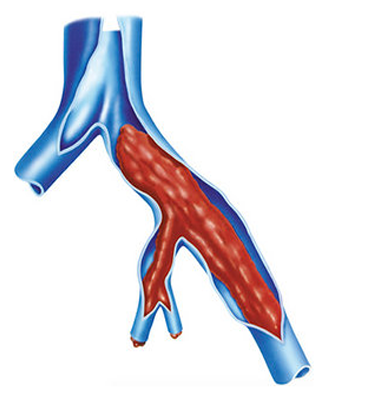Deep vein thrombosis (DVT) is a condition in which a blood clot develops in one of the primary veins of the pelvis, thigh, or calf, or less frequently the arms, abdomen, and chest. When a clot forms, it can extend to adjacent areas of the vein, triggering a localized inflammation that may encourage additional blood clot growth. A clot in a deep vein can also increase the potential for a dangerous complication, pulmonary embolism, in which a clot breaks free, travels through the bloodstream, and lodges in the lungs, where it can cause heart and lung collapse.Lower extremity deep venousdisease is the third most commoncardiovascular disease and is associatedwith significant individualmorbidity and high societal cost.


Deep vein thrombosis signs and symptoms can include:Swelling in the affected leg. Rarely, there’s swelling in both legs.
- Pain in your leg. The pain often starts in your calf and can feel like cramping or soreness.
- Red or discolored skin on the leg.
- A feeling of warmth in the affected leg.
Deep vein thrombosis can occur without noticeable symptoms.
The warning signs and symptoms of a pulmonary embolism include: - Sudden shortness of breath
- Chest pain or discomfort that worsens when you take a deep breath or when you cough
- Feeling lightheaded or dizzy, or fainting
- Rapid pulse
- Coughing up blood

Risk factors for DVT include:
- recent trauma
- major surgery
- cancer
- paralytic stroke
- estrogen treatment (birth control pills)
- immobilization
- obesity
- increased age, and history of previous clotting problems in the patient or family
Sometimes MR Venography is required to know extent of disease and May-Thurner syndrome. May-Thurner syndrome is a clinical entity of left iliac vein compression by the right iliac artery, resulting in isolated left lower extremity swelling and may be a precipitating factor for iliofemoral deep venous thrombosis. Magnetic resonance imaging is the best modality for diagnosis of this entity as it can rule out the presence of pelvic masses and deep venous thrombosis while simultaneously demonstrating the anatomy characteristic of this syndrome.
- Blood thinners. Deep vein thrombosis is most commonly treated with anticoagulants, also called blood thinners. …
- Compression stockings.
Endovascular treatment for Deep vein thrombosis include:
Acute DVT: Pharmacomechanical catheterdirectedtherapy (PCDT)
Chronic DVT: Stent placement in Iliofemoral or large veins in the setting ofchronic thrombotic and nonthromboticdeep venous diseasehas shown good long-term clinicaloutcomes.
- Stand-alone anticoagulant therapy fails to prevent Post thrombotic syndrome in a significant proportion of patients with acute proximal DVT, leading to significant disability, quality of life impairment, and socioeconomic costs
- Patients with iliofemoral DVT are at particularly high risk for Post thrombotic syndrome and late disability.
- Treatment strategies that feature early thrombus removal may prevent Post thrombotic syndrome
- CDT has significant potential toprevent Post thrombotic syndrome and offers distinct advantagescompared with surgical venousthrombectomy, systemic thrombolysis,and anticoagulation alone.
- Adjunctive CDT is likely to providefaster symptom relief than anticoagulationalone and does not increasethe risk of symptomatic PE.
fibrosis, and/or skin ulcerationmay develop.
Thrombolysis is a minimally invasive procedure in which we administer clot-dissolving drugs directly into the clot to break it up. During thrombectomy we use a catheter tipped with a tool that mechanically breaks up the clot or remove clot by catheter suction. These two procedures are sometimes used together, and are useful for very large clots or in people who are at high risk of developing a pulmonary embolism. Patients also receive anticoagulation before, during, and after endovascular treatment.
